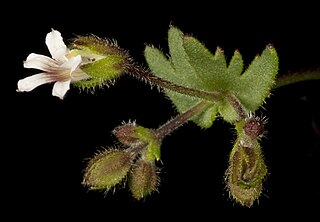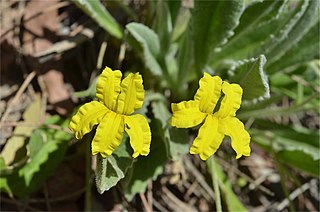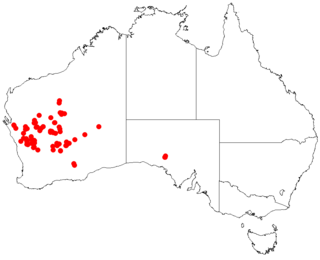
Goodenia caroliniana is a species of flowering plant in the family Goodeniaceae, and is endemic to eastern Australia. It is a perennial herb with egg-shaped to lance-shaped leaves with toothed edges and the narrower end toward the base, and erect flowering stems up to 50 cm (20 in) high and yellow flowers.

Goodenia connata, commonly known as cup velleia, is a species of flowering plant in the family Goodeniaceae, and is found in all mainland states and territories of Australia. It is a glabrous annual herb with a rosette of leaves at the base, and ascending flowering stems with yellow, brownish-yellow or white flowers, often with mauve markings.

Goodenia heterophylla is a species of plant in the family Goodeniaceae and is endemic to eastern Australia. It is an erect to trailing, more or less woody herb or shrub with linear to egg-shaped stem-leaves and racemes or thyrses of yellow flowers.

Goodenia amplexans, commonly known as clasping goodenia, is a species of flowering plant in the family Goodeniaceae and endemic to South Australia. It is a small shrub with sticky foliage, egg-shaped to oblong or elliptic, stem-clasping leaves with small teeth on the edges, racemes of yellow flowers with leaf-like bracteoles at the base, and elliptic fruit.

Goodenia bellidifolia, commonly known as daisy goodenia, is a species of flowering plant in the family Goodeniaceae and is endemic to eastern Australia. It is an erect, perennial herb with egg-shaped to lance-shaped leaves with the narrower end towards the base, spikes or thyrses of lemon-yellow to orange flowers, and oval to more or less spherical fruit.

Goodenia blackiana, commonly known as Black's goodenia, is a species of flowering plant in the family Goodeniaceae and is endemic to southern Australia. It is a herb with egg-shaped to lance-shaped leaves with the narrower end towards the base, and racemes of yellow flowers.
Goodenia campestris is a species of flowering plant in the family Goodeniaceae and is endemic to northern Australia. It is a low-lying herb with egg-shaped to lance-shaped stem leaves and racemes of yellowish flowers with purple veins.
Goodenia centralis is a species of flowering plant in the family Goodeniaceae and is endemic to central Australia. It is a prostrate, annual herb with coarsely toothed, spatula-shaped to egg-shaped leaves with the narrower end towards the base, and racemes of yellow flowers with purple veins.
Goodenia cusackiana is a species of flowering plant in the family Goodeniaceae and is endemic to the north-west of Western Australia. It an erect herb, densely covered with silvery hairs and has a woody stem, narrow elliptic to lance-shaped leaves, and racemes of yellow flowers.

Goodenia cycnopotamica is a species of flowering plant in the Goodeniaceae family and is endemic to Australia, found in both South Australia and Western Australia. It is an annual herb with oblong to lance-shaped leaves and pink or lilac to white flowers.
Goodenia havilandii, commonly known as hill goodenia, is a species of flowering plant in the family Goodeniaceae and is endemic to the drier parts of southern Australia. It is a prostrate to ascending, short-lived herb with sticky leaves and racemes of yellowish flowers with a brown centre.
Goodenia phillipsiae is a species of flowering plant in the family Goodeniaceae and is endemic to a restricted area in the south-west of Western Australia. It is an erect to spreading, glabrous shrub with oblong to linear stem leaves and thyrses of yellow flowers.

Goodenia pusilliflora, commonly known as small-flower goodenia, is a species of flowering plant in the family Goodeniaceae and is endemic to drier parts of southern Australia. It is a low-lying to ascending herb with oblong to egg-shaped leaves with toothed or lyrate edges, and racemes of small yellow flowers.
Goodenia quadrifida is a species of flowering plant in the family Goodeniaceae and is endemic to a restricted part of the Northern Territory. It is an ascending herb with glabrous foliage, narrow oblong to lance-shaped leaves at the base of the plant and racemes of purplish-brown flowers.

Goodenia robusta, commonly known as woolly goodenia, is a species of flowering plant in the family Goodeniaceae and is endemic to southern Australia. It is an erect or ascending perennial herb with crowded, hairy, elliptic to narrow oblong leaves at the base of the plant, and racemes of yellow flowers.

Goodenia daviesii, commonly known as hairy velleia, is a species of flowering plant in the Goodeniaceae family and is endemic to inland areas of Western Australia. It is an annual herb with lyre-shaped, pinnatifid leaves and lilac to white flowers.

Goodenia discophora, commonly known as cabbage poison, is a species of flowering plant in the Goodeniaceae family and is endemic to the south-west of Western Australia. It is a herb with lyre-shaped, pinnatifid leaves and yellow flowers.

Goodenia exigua is a species of flowering plant in the Goodeniaceae family and is endemic to the south of Western Australia. It is a stoloniferous, perennial plant with whorls of spatula-shaped leaves and yellow flowers.

Goodenia brendannarum is a species of flowering plant in the family Goodeniaceae, and is endemic to a small area in the south-west of Western Australia. It is a perennial herb with woody stems, crowded, narrowly egg-shaped leaves with toothed edges, and erect flowering stems and orange-yellow and red flowers.

Goodenia capillosa, commonly known as hispid velleia, is a species of flowering plant in the family Goodeniaceae and is native to inland areas of Western Australia and South Australia. It is an annual herb with covered with soft hairs, and has narrowly egg-shaped to narrowly elliptic leaves with toothed or lyre-shaped edges, and yellow flowers.
















